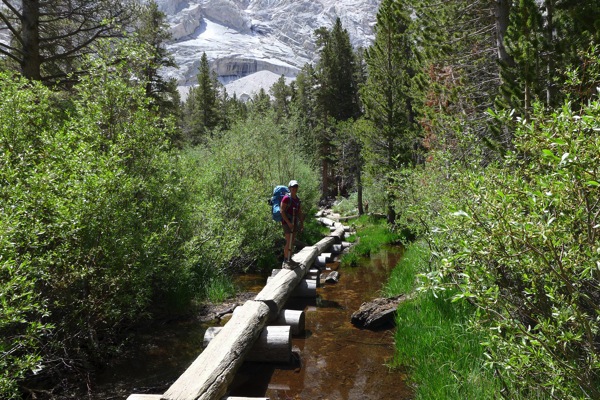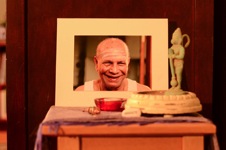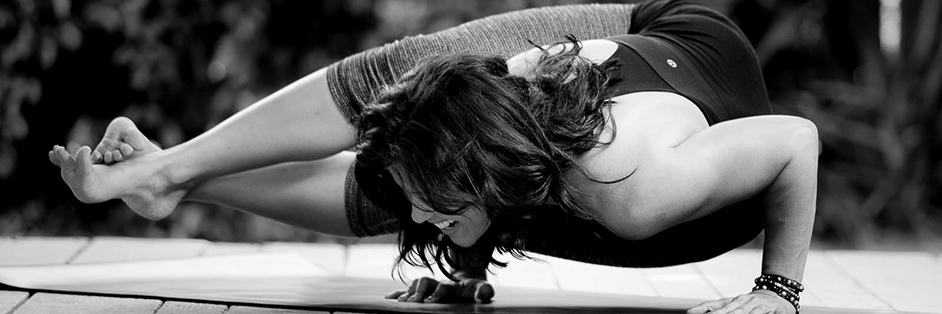work in progress
I spent a chunk of my Friday afternoon running through the yoga sequence I developed to finish off my 200h yoga instructor certification. Teaching this class to my teacher and peers is the final step for me to complete in order to be certified. That is, if my class is good enough to meet my teacher’s expectations.
Developing a set of asanas which will build up to and prepare the student for the selected peak pose is just the beginning of what she expects of her teacher trainees. The class must also contain certain components including the chant of aum (or other), some inclusion of pranayama, one or two principles from the eight limbs, and a theme which should not just be talked about at the beginning of class, but rather, woven into the sequence.
At this point in the game, I have my list of asanas leading up to my selected peak pose. I have selected my theme and my yogic principle from the eight limbs. I am now on my mat, stepping through the sequence, making adjustments where needed.
I am finding that there is nothing like moving through the set of asanas (exactly as they are listed out) to reveal the flaws in the sequence I’ve developed. What seemed like a good idea on paper does not quite flow as seamlessly as I hoped. Where these areas in my sequence don’t flow as well as they should, I have made the necessary modifications to insure that they do. And while it’s coming together nicely, I think I’d like to make a few more changes to make it a little more interesting and less repetitive. As if I am choreographing something as important as a ballet, I want everything to flow perfectly.
That’s asking a lot but, as I figure it, I must shoot for the stars so that I will have a better chance of success.
I must say, I now have an even more profound respect for my teachers for being able to create these masterpiece sequences week after week, day after day. A lot of thought goes into making sure the student’s body is warmed up properly before leading them into a more complex posture. Making each class now and interesting is an art that takes time to cultivate. Although I am sure the way I am developing my class is not the way of these experienced teachers, this is the process that makes sense for me right now. Hopefully, it will come easier after I have been doing this for a while.
Bridges
I have a certain attraction for bridges and what they represent. The concept of a gap being “bridged” to help one reach places otherwise inaccessible is beautiful. The process of crossing over is freeing.
I had previously seen an image of this log bridge while doing online preparations for a backpacking trip to Mount Whitney. The picture I’d seen showed snow on either side of the log bridge which, thankfully, has long since melted. At this point in my backcountry adventure, I am feeling the effects of the higher altitude — and, with just over 2 miles covered, our journey is just beginning. This bridge served as a tool for me to leave a large helping of insecurity and fears on the segment of trail behind me and welcome the adventure ahead.

Prior to this backpacking trip, I’d felt like my yoga practice had come to a similar juncture which needed me to bridge the gap to cross over to the other side. In the case of my practice, dropping back from standing into a backbend (wheel) would serve as my bridge. But unlike the cute little log bridge you see here, the potential for injury sometimes feels ominous. And yet…
There is something freeing in trusting my body’s ability to bend backward and take on the shape of a bridge. Oh yes, I have to come back up too. It seems like a lot and indeed it is. But have to believe.
I can do this…
Mysore Minus Coffee
I have to admit, I have not given up my morning coffee before my morning ashtanga practice. I switched to espresso last summer and felt that the four little gulps may theoretically do more for my bandhas (aiding in inducing elimination), than hindering it by filling my stomach with fluid. It’s about 4 ounces, if that.
Of course espresso does have caffeine… which stimulates the nervous system. This should serve as a strong argument for eliminating coffee before the morning practice, since the goal of the ashtanga yoga method is to calm the nervous system. However, my love for the taste of coffee has made this sacrifice a difficult one for me. I have switched to half-caff for a quite some time. Yesterday, I even had decaf.
Well, for some reason, I was compelled to try going without today. Instead of sipping my espresso as I got ready for mysore, I put my morning espresso in a thermos to enjoy after my practice.
I rolled out my mat hoping to find a little lightness and lift in my practice. Much to my surprise, the amount of thoughts whirling through my mind was exponentially greater than usual. I found myself forgetting poses in the sequence and having to either ask what was next or go moved on only to go back later to complete the skipped posture. By the time I got to the seated sequence, I was frustrated to no end. Things only got worse from here.
When I was met with my continued inability to lift up and jump back, not to mention the catching of my feet on the way through to seated (BOTH WITH BLOCKS), I was completely defeated. This was NOT the lightness and lift I’d hoped to see. Of course my hamstring continued to tug at the attachment — AND at my heartstrings. And all I could do was cry. I mean BREATHE!
I don’t know why I am surprised. I kind of makes sense when you think about what coffee does. But do I really need it?
One might argue that all of these issues I’ve noted appear to indicate a requirement for morning coffee – at least for me. Nevertheless, I am entertaining the notion that if I stick with (or “without”) it, I might find that I am able to cultivate my own ability to focus and generate strength without my daily fix. It’s a learning process but I think it could be good… after the initial adjustment period.
While I adjust, I may have to put a little note on my key chain to remind me not to forget my phone. Because poses weren’t the only thing I’ve forgotten today.
Letting go
I found myself looking forward to the next moon day after two and a half weeks practicing the full series daily. I’ve had a regular 6 day/week practice for a long time now, but I was only able to complete the full series every other day at most. To be honest, it isn’t just practicing the full series but honestly giving the jump-backs and jump-through the full effort needed to someday be able to incorporate these vinyasas into my practice. I’m elevated up on blocks, but deflated beyond words.
A week ago, I was in tears at several points in my practice, while memories from my childhood surfaced in my mind. I was reminded, “It’s supposed to be frustrating.” Day after day, frustration, tears, and memories came – and each day, my reaction has been a little different. A subtle awareness of becoming stronger lies just under the surface. Until one day, in spite of working hard, my muscles felt so fatigued that they were doing less lifting than before. My practice ended in a sweat saturated mess. Yet in spite of being aware of the building weakness, no tears or self bashing had occurred that day.
Then it was Saturday: our day of rest. Even so, I found myself practicing my jump-backs and jump-throughs a few times over… and over… and over. Normally, I wouldn’t think twice about me working through the mechanics on a Saturday, however that evening, my throat began to feel scratchy. Given the new level of consistency and intensity of my daily practice, I began to see the importance of “taking rest.” If that wasn’t enough, the signal to take a “Lady’s Holiday” reinforced the need for me to rest. And so, on Sunday, I watched my sweetheart prepare and leave for mysore without me. And still, I felt deprived even though, just days before, I’d been longing for a moon day. Sitting and simply observing my breath for about 30 minutes helped to dissipate some of this feeling.
Today was Day 3 of my cycle which, for me, pretty much means everything is back to normal as far as I can tell. One would think that I could return to my mat without any issue. In prior months, I might have done the majority of the practice but skipped the inversions. However, given the lingering scratchy throat, I entered the mysore room with plans for a gentle, abbreviated practice: stopping after the standing poses.
In the room, I could feel the momentum building all around me forcing me to pull my attention within so as not to get pulled further downstream than the standing poses as the rest of the mysoreans moved on in their practices. The undercurrent was strong today, and I nearly dove in. After completing the last of the standing series, I moved from downdog to my knees and contemplated my original plan. I thought, “What would the harm be in doing a couple of the seated poses?”
Perhaps there wouldn’t have been any harm done in my continuing into the seated postures. On the other hand, perhaps there would. As I contemplated continuing on, I looked at the blocks sitting alongside my mat. If I was going to continue, it only made sense to continue my work on the jump-backs and jump-throughs. That was when I decided to stop as planned. If there was any further downward (apanic) movement of energy happening, trying to lift off would NOT be helpful to that process. Therefore, I moved mat to the back of the room, did a few gentle spine extensions and then, I took rest.
Once in savasana, I felt my body completely let go — more so than I am usually aware of. A moment without whirling thoughts. Just silence and complete release. Ahhh…
as simple as a smile
I’ve been mostly home-based in my practice for the past 3 seasons… yet, only now, have I felt the need for a photo of Shri K. Pattabhi Jois (often referred to as “Guruji”). I found one on the internet, sent it to Shutterfly and printed a 5×7 for my home practice space. However, home is not where I have been practicing lately thanks to school being out. Oddly enough, the photo is still magical in its effect on me.

When I wake up and, due to increasing soreness, contemplate skipping my practice or staying home for an easier one, I remember the photograph. Even if it is not within view, I can still see Guruji smiling at me. There’s no arguing with that smile; I get out of bed and begin readying myself for mysore.
When I am in the room with all of my mysorean friends, moving through my practice and through the discomfort, I find gratitude in having the time and space to roll out my mat here. My teacher, Erika, and her assistants provide me with the cueing I need to keep me safe in my practice yet not allowing me to slack off. Their touch is a firm yet loving “hello” which lets me know that I am not alone – even though my “stuff” is mine and mine alone to work – although I have support in their presence in the many moments of frustration and tears that arise.
Although I am thankful for my home practice, it’s really good to not have to be alone all the time. I am thankful for the practice and for those who hold the space for me to work out the kinks (literally and so-to-speak).
When the time comes to roll up my mat, it isn’t just Guruji’s smile I see; I see those of my fellow mysoreans who have been doing their own work within the space. I am smiling too.
~ Namaste ~








